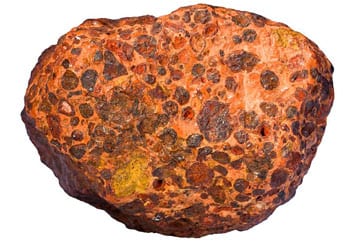Odaberite jezik:
Aluminijum je najčešće metalni element na zemlji., totaling about 8% Zemljine kore. Međutim, aluminum as an element is reactive and therefore does not occur naturally – it needs to be refined to produce aluminum metal. Osnovni početak materijala za rafiniranje aluminijuma je bauxit., glavni komercijalni izvor aluminijuma na svetu. Bauxite is a sedimentary rock, and consists mostly of the aluminium minerals gibbsite (Al(Oh)3), boehmita (γ-AlO(Oh)) i dijaspora (α-AlO(Oh)), and is usually mixed with the two iron oxides goethite and hematite, the aluminium clay mineral kaolinite and small amounts of anatase (TiO2) and/or ilmenite (FeTiO3).

Boksaski depoziti se šire širom svijeta., Uglavnom se događa u tropskim ili subtropskim regijama. Although proven reserves of bauxite are expected to last for many years, kvalitet rezervi koje može biti ekonomski pristupano opada. Za rafinere, who are in the business of bauxite processing to make alumina, i na kraju aluminijski metal, Ovo je izazov s obje finansijske i ekološke implikacije.
The process to refine metallurgical bauxite into alumina involves the following inputs:
The following outputs are generated:

The most widely used chemical process of refining bauxite into alumina, the Bayer process, involves dissolving the Al2O3 out of the bauxite rock with caustic soda (Nao) at elevated temperature and pressure. The Al2O3 fraction of the bauxite is dissolved into solution, to later be precipitated out as alumina. Međutim, a high-grade bauxite contains up to 60% Al2O3, and many operating bauxite deposits are well below this, povremeno nisko kao 30-40% Al2O3. Because the desired product is a high purity Al2O3, preostale oksidde u bauxitu (Fe2O3, SiO2, TiO2, Organic material) are separated from the Al2O3 and rejected as alumina refinery resides (ARR) or red mud. Općenito, "donja kvaliteta" bauxit (ie lower Al2O3 content) the more red mud is generated per ton of alumina product. Osim toga, even some Al2O3 bearing minerals, posebno kaolinite, produce un-desirable side reactions during the refining process and lead to an increase in red mud generation, kao i gubitak skupe uzroke sode, velika varijabilna cijena u procesu rafiniranja bauxita.
Crveno blato ili ARR predstavlja veliki izazov za Aluminijumske industrije.. Crveno blato sadrži značajne ostatke kemijskih ostataka od procesa rafiniranja, i veoma je alkalan., često sa pH 10 – 13. It is generated in large volumes worldwide – according to the USGS, procijenjena je globalna alumina produkcija 121 miliona tona u 2016. This likely resulted in more than 150 milion tona crvenog blata proizvedena u istom periodu. Uprkos tekućim istraživanjima, crveno blato trenutno ima nekoliko komercijalnih puteva za korisnu upotrebu.. Procjenjuje se da se vrlo malo crvenog blata korisnika ponovo koristi širom svijeta.. Instead the red mud is pumped from the alumina refinery into storage impoundments or landfills, Gdje je pohranjen i nadgledani pod velikim troškovima.
Gubitak skupe kastične sode (Nao) and the generation of red mud are both related to the quality of the bauxite used in the refining process. Općenito, the lower the Al2O3 content of the bauxite, veći obim crvenog blata koji će biti generisan, as the non-Al2O3 phases are rejected as red mud. Osim toga, the higher the kaolinite or reactive silica content of the bauxite, više crvenog blata će se generisti. The reactive silica content not only increases the volume of red mud, but also consumes caustic soda reagent and reduces the yield of Al2O3 recovered from the bauxite. Stoga, there is both an economic and environmental argument to be made for improving the quality of bauxite prior to refining.
Proces razdvojenosti stet-a nudi boksita producentima ili bauxitovim rafinerima priliku da obavljaju pregradnju bauxita rude da poboljša kvalitet. Ovaj pristup ima mnogo prednosti.:
Ukratko, suvi obrađivanje sa separatorom STET-a nudi mogućnosti da stvori vrijednost za proizvođače boksita i rafinere. Pretobradu bauxita prije rafiniranja će smanjiti kemijske troškove, smanji obim crvenog blata generirane i minimizirati uznemirenu proceduru.
Reference: